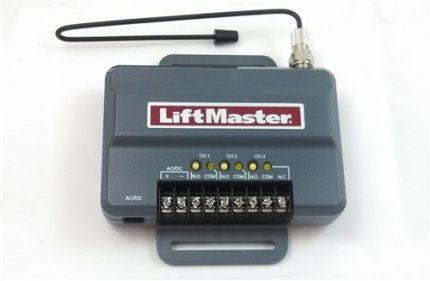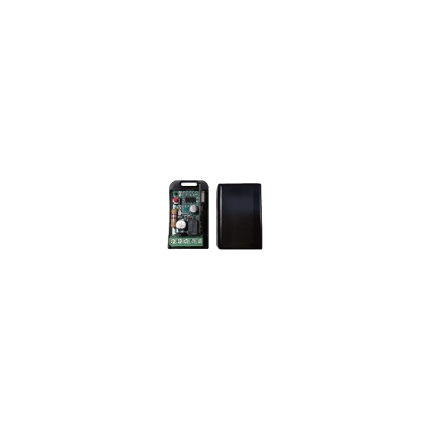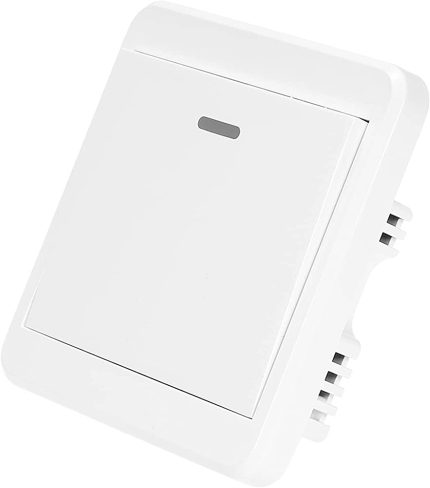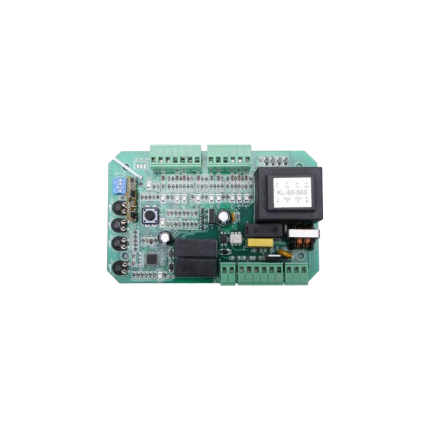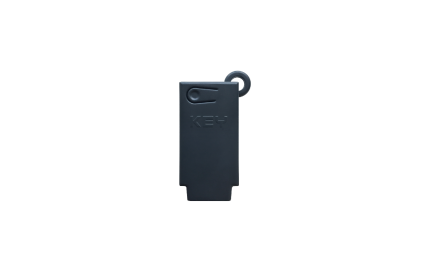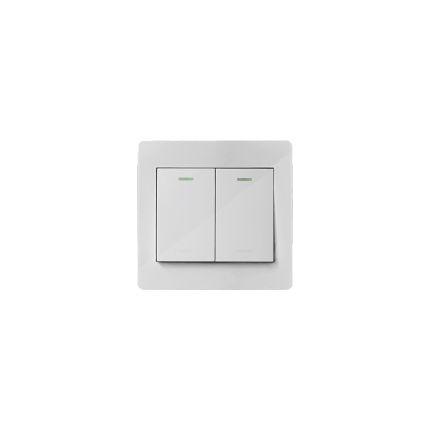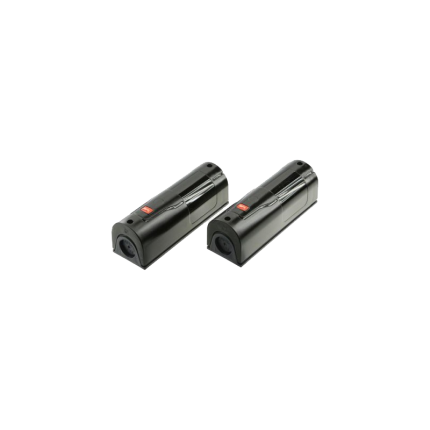Accessories
Radio receiver – LiftMaster 850LM – 3 Channels
Ship or pick up from our office.
Radio receiver – LiftMaster 850LM – 3 Channels
Universal Radio Receiver LiftMaster 850LM is used for garage doors and driveway gate operators.
- Universal Radio Receiver Liftmaster 850LM is suitable for residential and commercial sliding gates and swing driveway gates.
- Security Encrypted Code For Extra Dependability.
- Manage Multiple Access Points With A Single LiftMaster Radio Receiver.
- 3 channels for control of 3 driveway gate openers.
Radio receiver RQ1M433 – IT1
PIR Infrared Sensor – wireless
Ship or pick up from our office.
PIR Infrared Sensor – wireless
A wireless PIR (Passive Infrared) sensor is a type of motion detector that uses infrared technology to detect the presence and movement of people, animals, or other warm objects within its field of view, and then transmits this information wirelessly to a central control unit. Here's a breakdown of its key aspects: PIR (Passive Infrared) Technology:- Passive: The "passive" in PIR means the sensor does not emit any energy (like radar or ultrasonic sensors do). Instead, it "passively" detects the infrared radiation (heat energy) naturally emitted by all objects with a temperature above absolute zero.
- Infrared Detection: All living beings (humans, pets) and warm objects emit infrared radiation.
- How it works: A PIR sensor typically has two sensing elements within its housing. When no motion is present, both elements detect the same amount of infrared radiation from the ambient environment. When a warm body moves across the sensor's field of view, it first enters one sensing element's range, causing a rapid change in the infrared energy detected by that element. As the body moves further, it then affects the second element. This differential change in infrared energy between the two elements is what the sensor interprets as motion.
- Fresnel Lens: PIR sensors often have a specialized faceted lens (a Fresnel lens) on their front. This lens helps to focus the infrared radiation onto the sensing elements and creates multiple "detection zones" or "fingers" within the sensor's field of view, which increases its coverage and sensitivity.
- No Wires for Communication: The "wireless" aspect means the sensor communicates with the alarm system's control panel (or receiver) using radio frequencies (RF) rather than physical wires.
- Battery Powered: Wireless PIR sensors are usually battery-powered, making them easy to install anywhere without needing to run electrical wiring. The batteries typically last for a significant period (months to years) before needing replacement.
- Transmitter: Each sensor has a small radio transmitter that sends a signal to the central alarm panel when motion is detected.
- Receiver: The alarm control panel has a built-in or external wireless receiver that listens for signals from the PIR sensors (and other wireless sensors like door/window contacts).
- Easy Installation: No need for complex wiring, making DIY installation simpler and reducing labor costs for professional installers. This is a significant advantage in existing structures where running wires might be difficult or aesthetically unappealing.
- Flexible Placement: Can be mounted virtually anywhere within their effective range of the control panel, providing versatile coverage.
- Reduced False Alarms (Compared to Simple Motion Detectors): Because PIR sensors detect heat signatures, they are less likely to be triggered by non-living things like swaying curtains, blowing leaves, or shadows (though extreme drafts or sudden temperature changes can still be an issue if not properly installed).
- Pet Immunity: Many wireless PIR sensors offer "pet immunity" features. These sensors are designed to ignore the infrared signatures of smaller animals (below a certain weight, e.g., 40 lbs or 80 lbs), helping to prevent false alarms in homes with pets. This is achieved by adjusting the sensor's lens and internal logic to focus on specific infrared patterns that are indicative of human-sized targets.
- Energy Efficiency: As passive devices, they consume very little power, contributing to long battery life.
- Comprehensive Coverage: Ideal for protecting large areas or rooms, as a single sensor can cover a significant space.
- Integration: Seamlessly integrate with smart home security systems, allowing for remote monitoring, alerts via smartphone apps, and sometimes even integration with other smart devices (e.g., turning on lights when motion is detected).
- Home Security Systems: Widely used indoors to detect intruders in living rooms, hallways, bedrooms, and basements. Outdoor-rated versions are also available for perimeter protection.
- Commercial Security Systems: Protecting offices, warehouses, retail spaces, and other commercial properties.
- Automated Lighting: Activating lights in rooms, hallways, or outdoor areas when someone enters.
- Smart Home Automation: Triggering various smart home routines based on occupancy (e.g., adjusting thermostat, playing music).
- Access Control: Monitoring movement in restricted areas.
- Placement: Proper placement is crucial to avoid false alarms. Avoid aiming them directly at heat sources (vents, radiators, direct sunlight, fireplaces), areas with strong drafts, or windows (especially those exposed to direct sun or busy outdoor activity).
- Pet Immunity Settings: If you have pets, ensure the sensor has pet immunity and that it's set correctly for your pet's size and the sensor's mounting height.
- Signal Range: Ensure the sensor is within the wireless range of your alarm panel, considering walls and other obstructions that might weaken the signal.
- Battery Life: Be mindful of battery replacement schedules to ensure continuous operation.
Garden LED Light -Key Automation STIKVC
Ship or pick up from our office.
PRODUCT SHEET PDFGarden LED Light -Key Automation STIKVC
*Lights for pedestrian or vehicular premises are to be installed on top of the fence *Completely made of aluminum *Replaceable LED *Power: 24-35 V/DC - 2W *Body color: Corten *LED color: 4400K/132lm *Height: 246 mm *Version: Vertical face *International Protection Rating: IP 54Garden LED Light -Key Automation STIKDC
Ship or pick up from our office.
PRODUCT SHEET PDFGarden LED Light -Key Automation STIKDC
*Garden lights with a height of 40 cm with front light *Completely made of aluminum *Replaceable LED *Power: 24-35 V/DC - 2W *Body color: Corten *LED color: 4400K/132lm *Height: 404 mm *Version: Ground facing *International Protection Rating: IP 54Radio receiver RQ2C433A – IT2
Sliding gate operator main control board – Difermatic
Ship or pick up from our office.
Sliding gate operator main control board – Difermatic
The main control board for a Difermatic sliding gate operator, such as the DSL600, acts as the "brain" of the system, managing all the gate's functions.
It receives commands from remote controls or other inputs, and then controls the motor to open and close the gate. It also manages safety features like obstacle detection and may allow for adjustments to speed, force, and other parameters.
Key Functions:
- Receives and Processes Commands: The control board receives signals from remote controls, keypads, or safety sensors.
- Controls the Motor: It sends instructions to the gate's motor to open or close the gate based on the received commands.
- Manages Safety Features: Many control boards include safety features like obstacle detection (which can reverse the gate's direction if it encounters an obstruction) and slow-down functions.
- Adjustable Settings: Some models allow for adjustment of speed, force, and other parameters.
- Power Supply: The control board typically operates on a 24V power supply.
Specific to Difermatic:
- The Difermatic DSL600 is a 600kg sliding gate opener, indicating the weight capacity of the gate it's designed to handle.
- Difermatic products are known for their Italian design and quality.
- The control board likely has features like remote control operation, safety mechanisms, and adjustable speed and force settings.
Additional Notes:
- Many sliding gate control boards, including those from Difermatic, are designed for easy installation and user-friendly operation.
- They often include a built-in receiver for remote controls and may be compatible with other accessories like photocells and alarm lamps.
- Some control boards also feature automatic closing functions and can be programmed for various delay times.
Programmer module -Key Automation KUBEPRO
Ship or pick up from our office.
PRODUCT SHEET PDFProgrammer module -Key Automation KUBEPRO
*KUBEPRO - Installer Version *Smartphone programming for 14A and HALO control boardsThe Key Automation KUBEPRO is a programmer module that allows professional installers to configure and manage Key Automation gate and door operators using a smartphone.
It connects via Bluetooth to the installer's smartphone and allows them to adjust parameters, set up the gate opener, and manage other aspects of the automation system.
The KUBE PRO also includes the KEY CLOUD service for data viewing, backup, team management, and maintenance scheduling.
Here's a more detailed breakdown:
-
Purpose:The KUBEPRO is designed for professional installers to configure and manage Key Automation gate and door operators.
-
Functionality:It allows installers to adjust various parameters, set up the gate opener, and manage other settings directly from their smartphone.
-
Connectivity:It connects to the gate operator's control board and uses Bluetooth to communicate with the installer's smartphone.
-
Smartphone App:An app, specifically designed for professional installers, is used to interact with the KUBEPRO module.
-
KEY CLOUD:The KUBE PRO module includes KEY CLOUD, a cloud-based service for storing data, managing teams, and scheduling maintenance.
-
Accessibility:The KUBE PRO module is restricted to users with a Key Automation account, ensuring proper authorization and usage.
Sliding gate operator main control board – Zero
Ship or pick up from our office.
Sliding gate operator main control board – Zero
The sliding gate operator main control board (also referred to as a PCB or circuit board) is the central component that manages all the functions of an automatic sliding gate system.
It acts as the "brain" of the gate, receiving signals from various input devices (like remote controls, keypads, or safety sensors) and translating them into actions for the gate's motor and other components.
Here's a more detailed breakdown:
1. Central Control: The control board is the central hub for all gate operations. It receives signals from different sources, such as:
- Remote controls: For opening and closing the gate.
- Keypads: For authorized access.
- Safety sensors: To detect obstructions and prevent accidents.
- Other accessories: Such as loop detectors, intercom systems, etc.
2. Signal Processing: The control board interprets the signals it receives and determines the appropriate action for the gate.
3. Motor Activation: Based on the processed signal, the control board sends instructions to the gate's motor to either open or close the gate.
4. Adjustable Settings: The control board often allows for adjustments to various parameters, including:
- Gate speed: The speed at which the gate opens and closes.
- Opening and closing timers: To control the duration of the gate's movement.
- Safety features: Including force adjustments, obstacle detection sensitivity, and slow-down settings.

